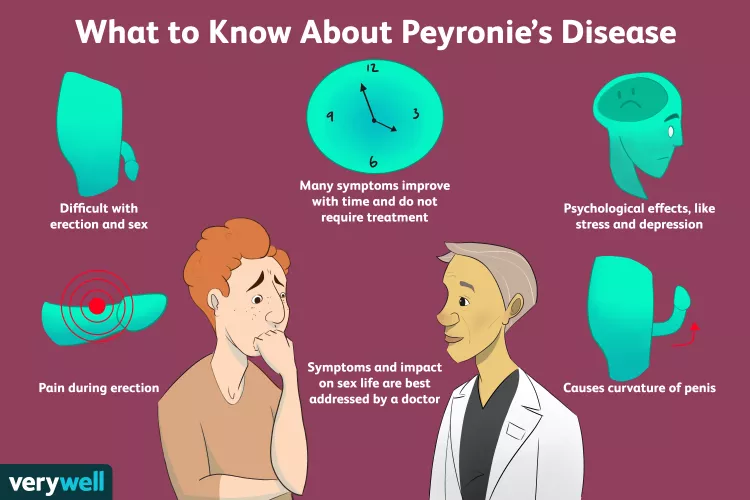
16 Oct Think you have Peyronie’s Disease? Here is what you need to know
For a more detailed guide to Peyronie’s Disease, click here to download our thorough guide.
Have you recently been diagnosed with Peyronie’s Disease, or do you suspect you might have it? While Peyronie’s Disease is not typically a cause for immediate concern, it can bring about pain and discomfort for some men. In this comprehensive guide, we aim to provide valuable information and support to anyone who may be dealing with this condition.
What are the symptoms
The most common sympton’s for those experiencing Peyronie’s disease include the following:
- Penile curvature – may develop a curve or bend during erections.
- Scar tissue: Plaque or fibrous tissue forms under the skin, often causing a lump or hard area.
- Erectile dysfunction: Some individuals may experience difficulties in achieving or maintaining an erection.
- Pain: Pain may be experienced, particularly during erections.
- Shortening of the penis: In some cases, Peyronie’s disease can lead to a reduction in penile length.

Who is likely to suffer from Peyronie’s Disease
Peyronie’s Disease typically targets men aged between 40 and 70, with its prevalence highest within this age range. Additionally, certain risk factors have been identified, making it more common in individuals with a family history of connective tissue disorders and those who smoke.
How is it diagnosed
A physical examination of the penis provides an initial assessment, while ultrasound serves as a valuable tool for visualizing the plaque and scar tissue.
Does it get worse over time / can you ignore the problem?
Peyronie’s Disease may worsen over time but it doesn’t always. It is important to not overlook the condition, as ignoring it could potentially lead to complications. We recommend taking immediate action and coming up with a plan for treatment with your GP if you suspect you have Peyronie’s Disease.
What are the causes
It’s not always clear, but it’s thought to involve trauma or injury to the penis as a primary trigger for Peyronie’s Disease. Additionally, genetic predisposition, connective tissue disorders, and certain lifestyle factors like smoking may also contribute to the development of this condition. Understanding these potential causes can help individuals better manage and address their Peyronie’s Disease.
Is there any alternative/home based treatments
Penis traction devices have been known to offer assistance in reducing curvature in some cases. These devices are designed to gently stretch the penile tissues, potentially helping to alleviate the effects of Peyronie’s Disease. In addition to traction devices, healthcare professionals may also recommend the use of topical gels or creams as part of the treatment plan. These topical applications can contain active ingredients aimed at minimizing discomfort and promoting healthier tissue in the affected area. When considering treatment options for Peyronie’s Disease, consulting a healthcare provider for personalized guidance is essential to determine the most suitable approach for one’s specific situation.
Treatment options
Treatment options for Peyronie’s Disease include the following:
- Surgery: Surgical options include procedures to straighten the penis or remove the plaque.
- Nesbit’s Procedure
- Shockwave Therapy
What is the cost of treatment?
The cost of treatment or surgery for Peyronie’s disease in Australia can vary widely depending on factors like the specific procedure, location, and healthcare provider. However we would suggest the following as a guide:
- Out of pocket cost: Approx $3000
- Medicare Rebate: $600 Approx
Please note this does not include hospital, pharmaceutical and anaesthetist costs
Can viagra fix the issue
Partially, Viagra or similar medications may aid in improving erectile function, yet they do not address the underlying curvature resulting from Peyronie’s disease.
How much length is lost
The extent of lost length can fluctuate, contingent on the severity and placement of the plaque – every situation is different.
Does it affect erections
Yes – Peyronie’s Disease can lead to erectile dysfunction in some cases.
What can Peyronie’s Disease be mistaken for
Peyronie’s disease can sometimes be misinterpreted as several other conditions due to its variable symptoms. Initially, it might be mistaken for an isolated case of erectile dysfunction, as the curvature and deformity of the penis can affect its functionality. Additionally, Peyronie’s disease can be confused with various other penile conditions, such as congenital curvature, penile fracture, and, in rare instances, conditions like penile cancer, scleroderma, or other forms of fibrosis. Furthermore, it can share symptoms with genital warts, lipomas or cysts, and Balanitis Xerotica Obliterans (BXO), making an accurate diagnosis crucial for proper treatment and management.




No Comments